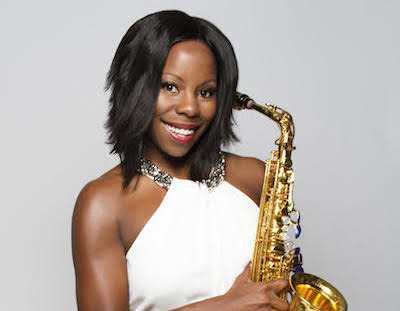Apr 2, 2024 12:59 PM
Saxophonist, Sonic Explorer Casey Benjamin Dies at 45
Casey Benjamin, the alto saxophonist, vocalist, keyboardist and producer who stamped his distinctive sounds on the…

Tia Fuller performed at the Dominican Republic Jazz Festival on Nov. 10.
(Photo: Courtesy of the artist)For its 20th-anniversary edition, which took place Nov. 9–12, the Dominican Republic Jazz Festival, curated by Artistic Director Marco Pignataro from Berklee Global Jazz Institute, booked a program comprised entirely of female bandleaders. This was a major statement in a country where domestic violence claims the lives of hundreds of women per year.
In addition to their concerts, each artist—they included Esperanza Spalding, Terri Lyne Carrington, Geri Allen and Tia Fuller—was contractually obliged to conduct at least one workshop as well as classes with children in the under-funded public schools of the resort communities on the Dominican Republic’s north coast, where luxury hotels and gated private enclaves stand across the road from impoverished neighborhoods.
After opening night in Santo Domingo—the southern coastal city in which pianist Joanne Brackeen performed with a Berklee student ensemble called the Global Jazz Ambassadors—DRJF moved north to Santiago, where the proceedings transpired in a tented, open-air plaza behind the Centro León museum, which frequently hosts cultural activities.
The evening opened with a quintet led by recent BGJI graduate Lihi Haruvi, a young Israeli alto and soprano saxophonist, with pianist Caili O’Doherty, electric mandolinist Jacob Means, bassist Ehud Ettun and drummer Cory Cox. They performed a seven-piece program comprised of four Haruvi-arranged songs composed or popularized by Israeli women, as well as three of Haruvi’s tunes.
Haruvi clapped her hands as she assumed the bandstand. Her bandmates followed suit, then started the Balkan-sounding theme of Haruvi’s “Hamsa Hamsa,” titled, the composer explained, to acknowledge both hamsa’s Arabic meaning as the number 5 (represented by the double-grouping of 5 quarter notes in the first section), but also to denote the expression’s frequent Israeli usage as “good luck.”
Means mirrored Haruvi’s soprano saxophone melody statement, then the flow morphed to a rubato space, defined by O’Doherty’s Robert Glasper-esque melodies over Cox’s Damion Reid-like drum chants. Means skronked out; Haruvi returned for a forceful improvisation, concluding with an extravagant coda.
There followed “You Took My Hand In Yours,” by Matti Caspi. Haruvi, now on alto saxophone, stated the theme, which included a section vaguely reminiscent of Horace Silver’s “Song For My Father” and another that evoked Russian folk music. O’Doherty uncorked a swinging, thematically cohesive solo, devoid of clichés, that illuminated the song’s soulfulness. Haruvi wove together motivic fragments into a unitary quilt, blowing hard throughout.
Cox’s dark-toned, mallet solo and Ettun’s upper register bass variations introduced Mordechai Zeira’s “Two Roses,” whose many interpreters, Haruvi said, include “Queen Of Hebrew Music” Shoshana Damari.
Haruvi’s alto saxophone stated the stark, mysterious theme. (The song portrays a white rose and a red rose that grew and bloomed together until one rose was picked by hand, breaking the heart of the rose left behind.) She switched to soprano sax for a passionate improvisation. O’Doherty dug into the melody with bell-like tone, and Ettun soloed to his own vocal accompaniment, before Haruvi returned, first stating the theme with delicacy, then ratcheting up the intensity for a praiseful ending.
Haruvi navigated the bittersweet refrain of Zeira’s “There Were Nights” with pointillistic focus. The song’s subject is tragic—a woman reminiscing about a dead lover—but Haruvi projected an affirmative attitude in a forceful alto-drums duo with Cox in which she coalesced fragmentary phrases into long, wild lines, before a backbeat-fueled finale.
On “Interlude,” an original tune, Haruvi moved from a rubato treatment of the melody to whirlwind velocity, then returned to a ruminative mood that O’Doherty picked up as Cox countered with double-time beats.
Haruvi explored extended techniques with klezmer intensity before resolving—perhaps a bit self-consciously—into a swinging passage. O’Doherty reaffirmed the swing with a bluesy solo, at one point quoting “Softly As In A Morning Sunrise.” Haruvi resumed with swoops that matched the mandolin’s tonality, then, on her final go-through, fragmented the theme into different shapes.
A highlight of “Right Now It Doesn’t Seem Too Good,” by Chava Alberstein, was O’Doherty’s refraction of Chick Corea in yet another swinging solo; Haruvi ended this well-played set with the funky “All The People In The World,” which began with a theme that held connotations of “Jean-Pierre,” transitioned to a playful bebop line, and ended as a soulful blues

Benjamin possessed a fluid, round sound on the alto saxophone, and he was often most recognizable by the layers of electronic effects that he put onto the instrument.
Apr 2, 2024 12:59 PM
Casey Benjamin, the alto saxophonist, vocalist, keyboardist and producer who stamped his distinctive sounds on the…

“He’s constructing intelligent musical sentences that connect seamlessly, which is the most important part of linear playing,” Charles McPherson said of alto saxophonist Sonny Red.
Feb 27, 2024 1:40 PM
“I might not have felt this way 30 to 40 years ago, but I’ve reached a point where I can hear value in what people…

Albert “Tootie” Heath (1935–2024) followed in the tradition of drummer Kenny Clarke, his idol.
Apr 5, 2024 10:28 AM
Albert “Tootie” Heath, a drummer of impeccable taste and time who was the youngest of three jazz-legend brothers…

“Both of us are quite grounded in the craft, the tradition and the harmonic sense,” Rosenwinkel said of his experience playing with Allen. “Yet I felt we shared something mystical as well.”
Mar 12, 2024 11:42 AM
“There are a few musicians you hear where, as somebody once said, the molecules in the room change. Geri was one of…

Larry Goldings’ versatility keeps him in high demand as a leader, collaborator and sideman.
Feb 21, 2024 10:45 AM
Are you having any fun? Larry Goldings certainly is. Consider just two recent examples:
Scene 1: “If anyone had…